St. Theodore the Studite
Scroll for quotes→
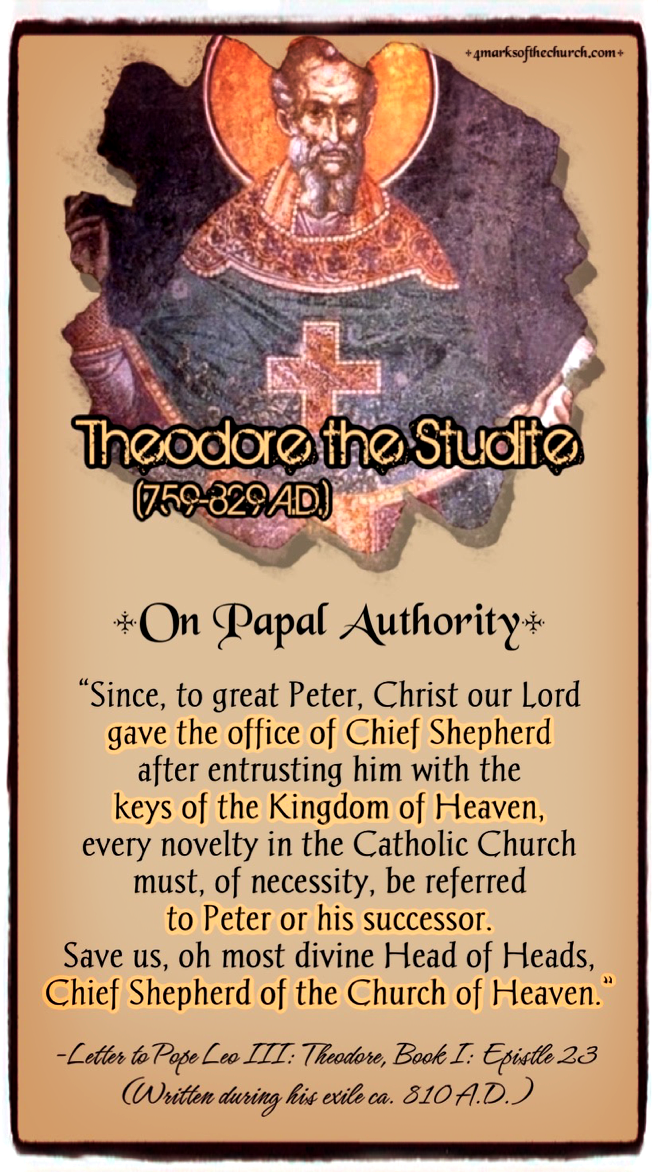
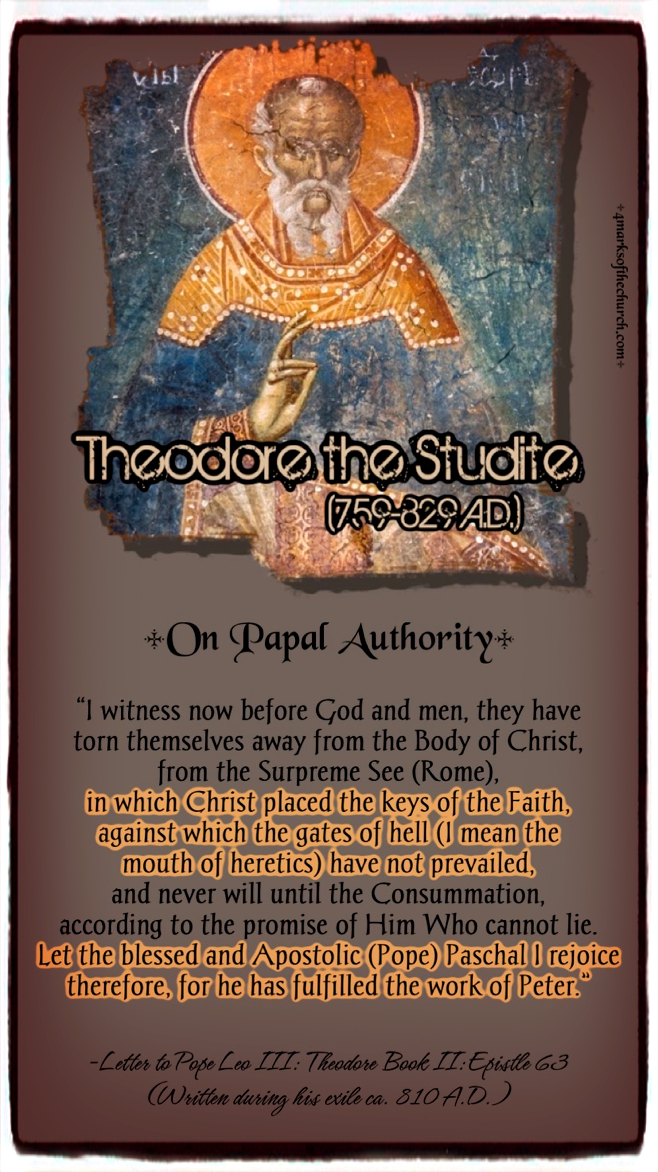
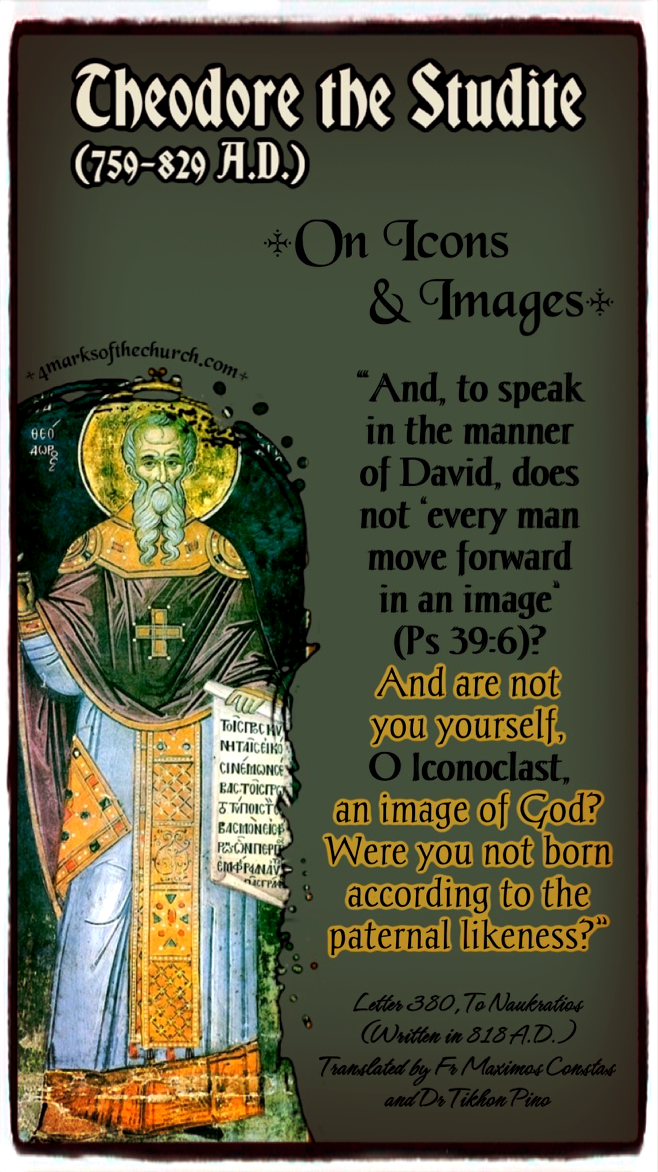
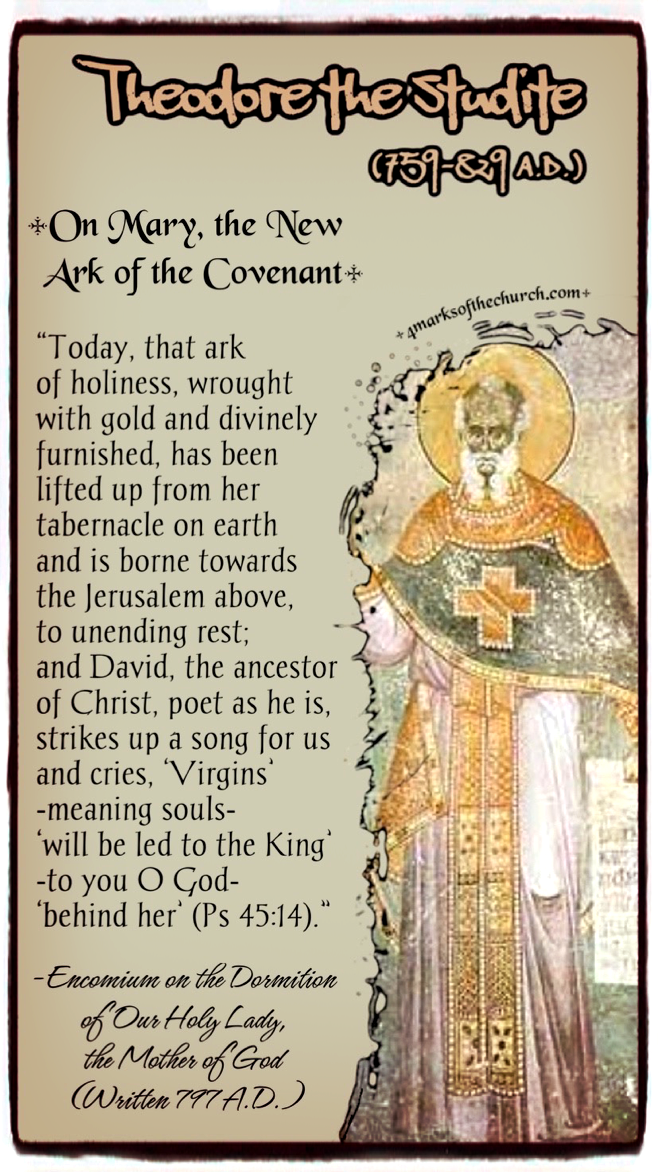
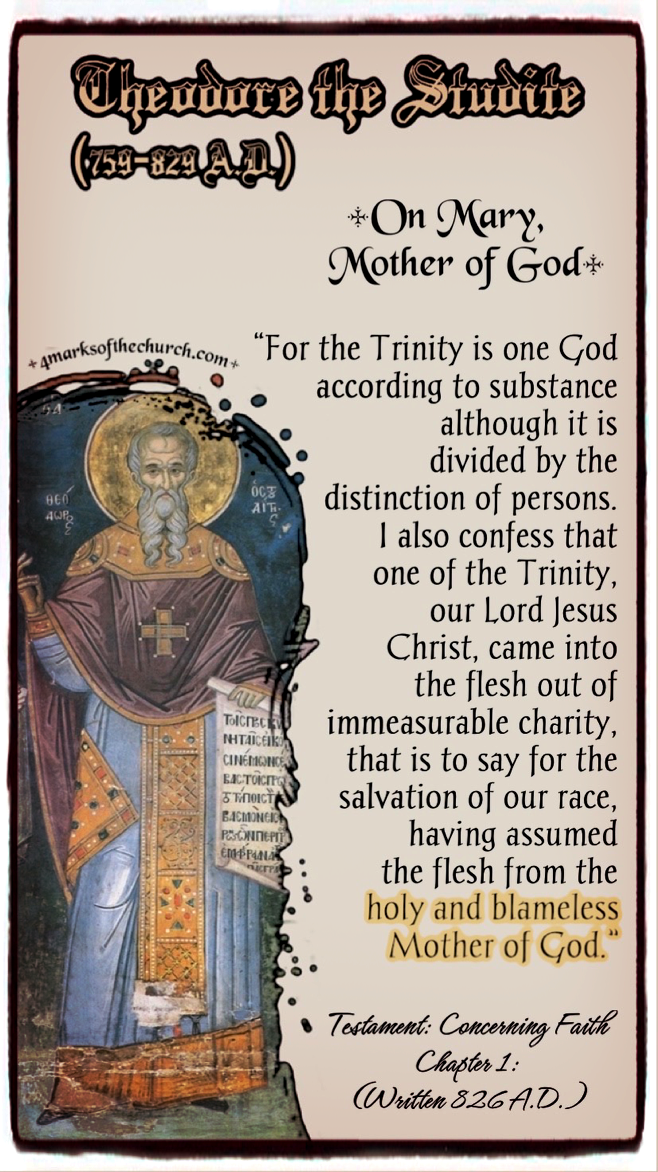

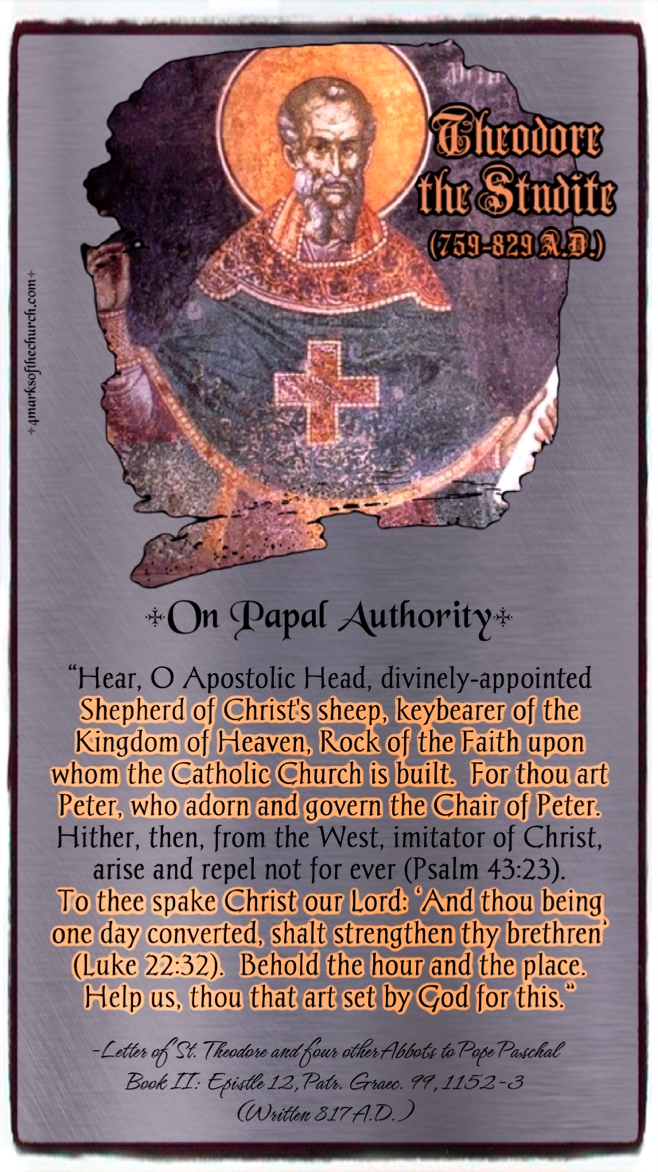
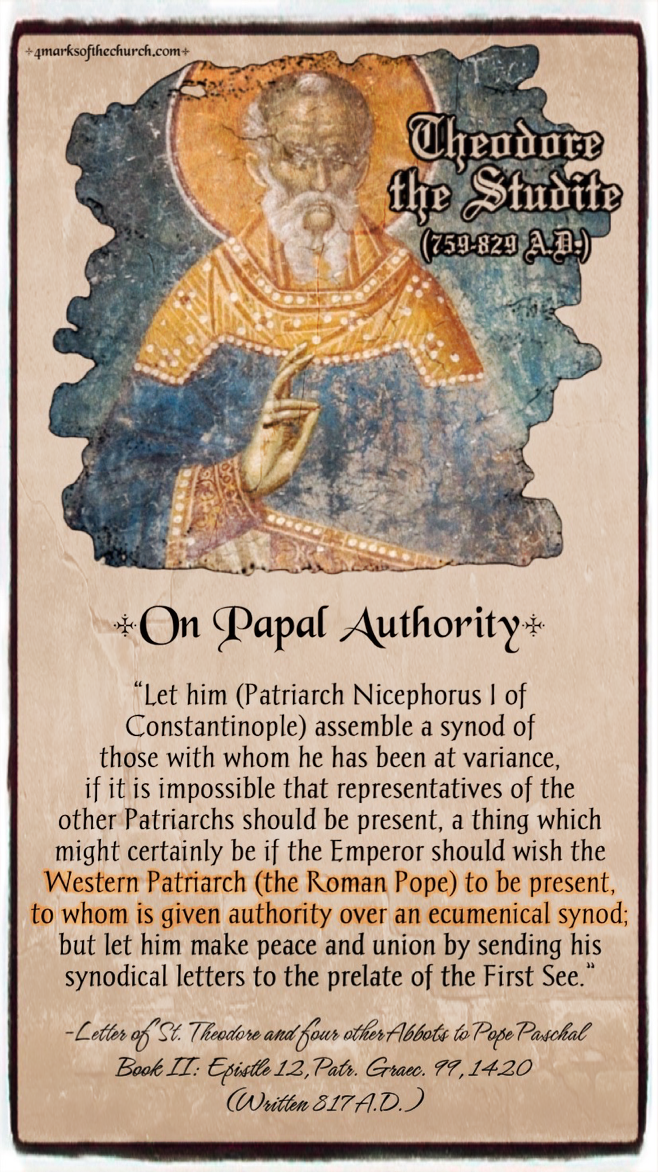
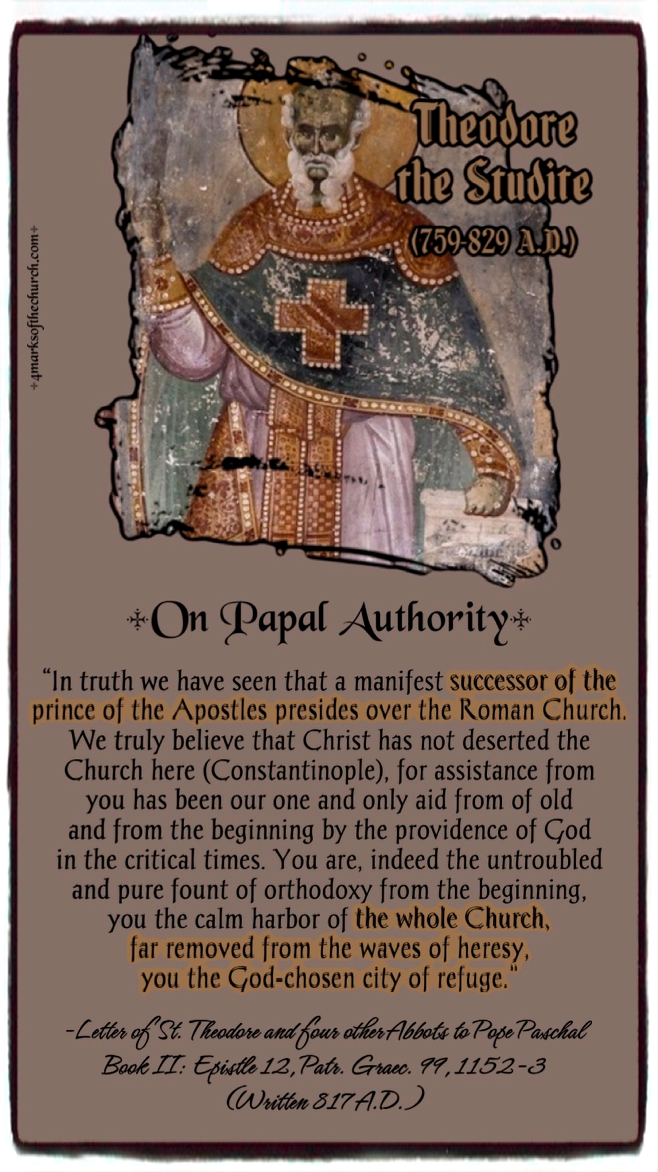

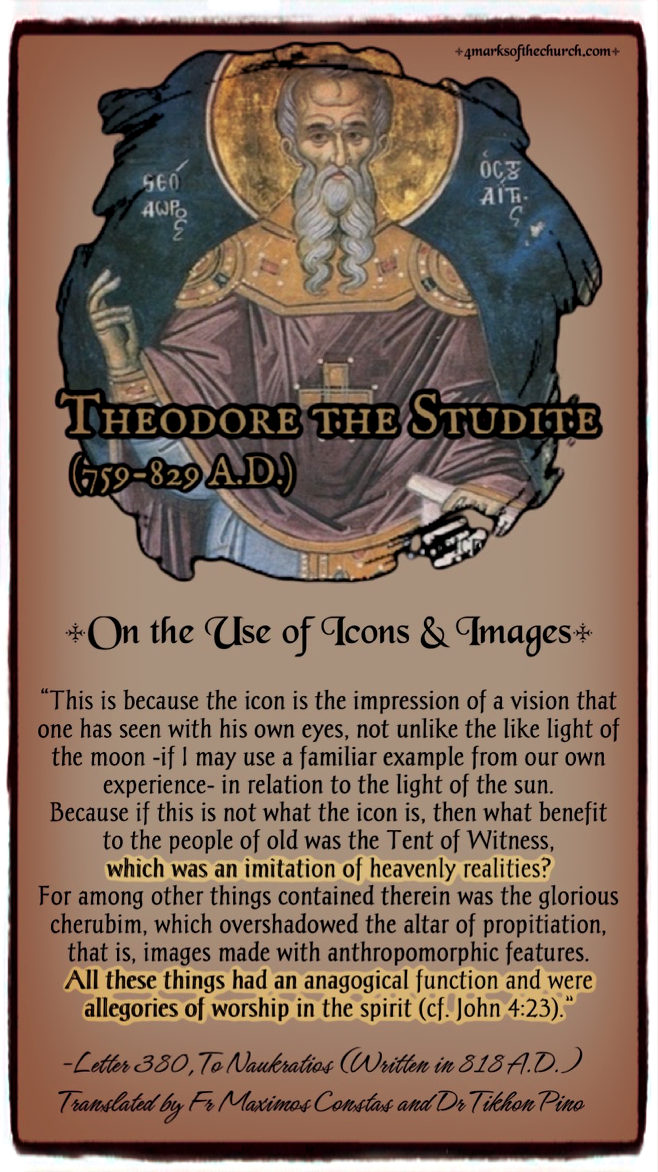
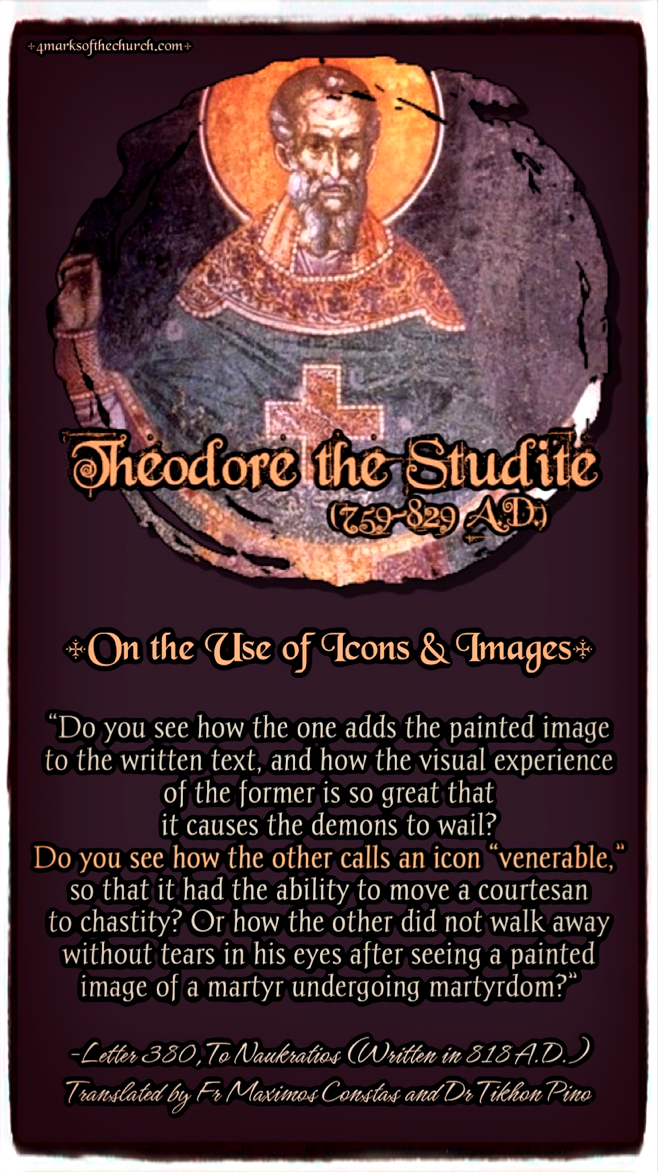
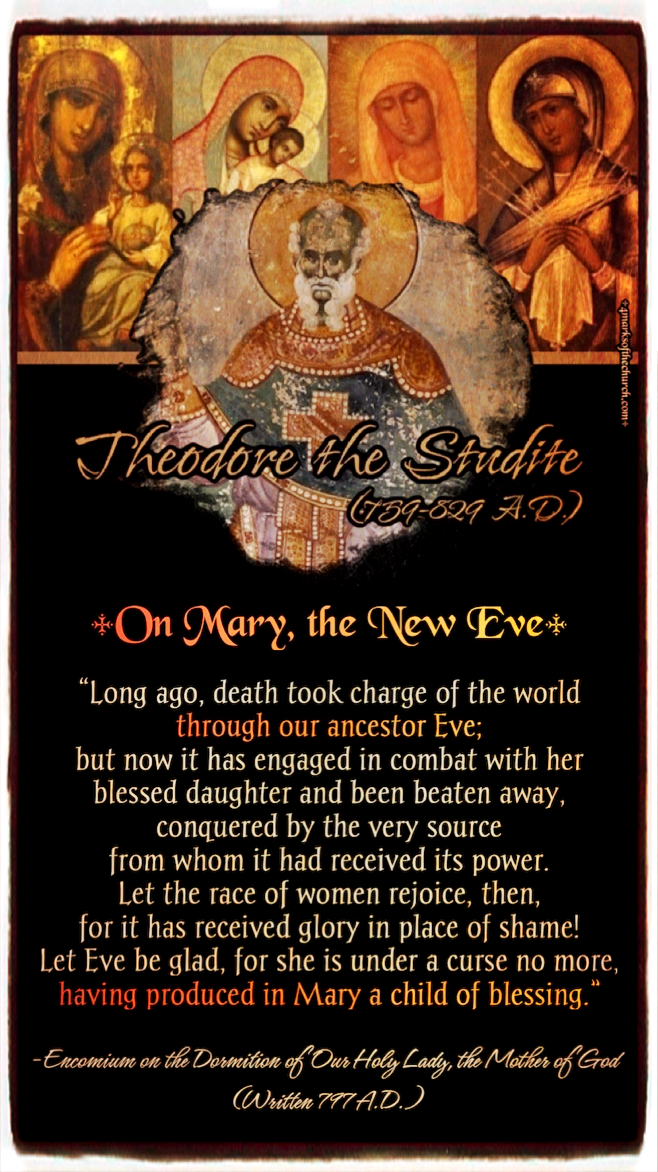


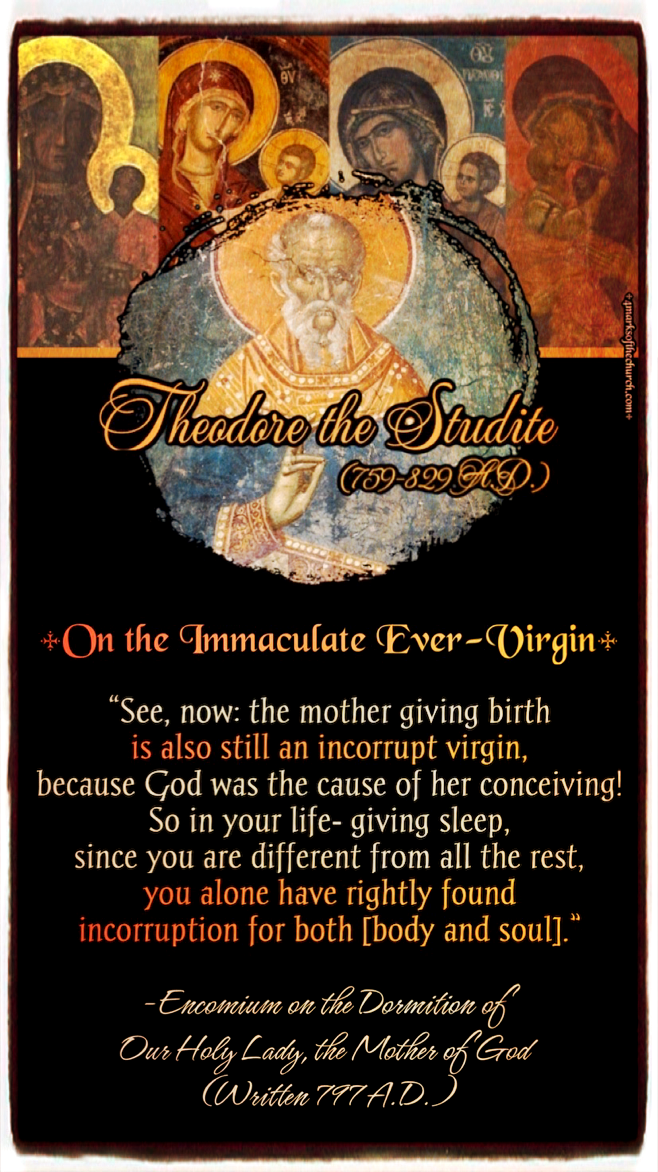
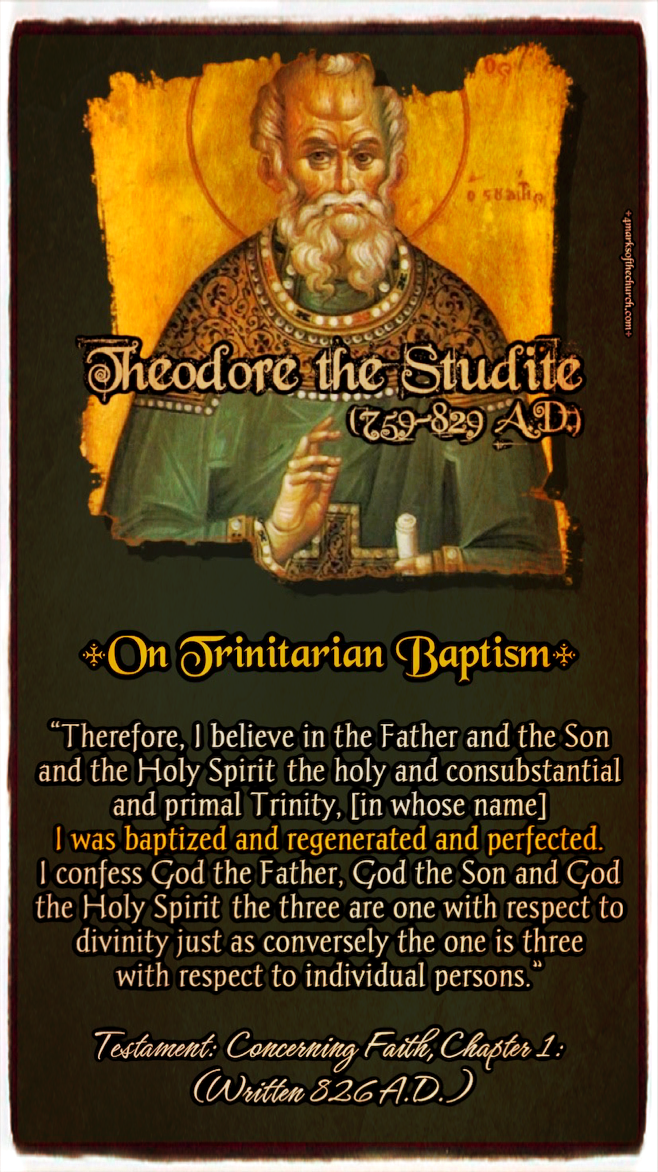
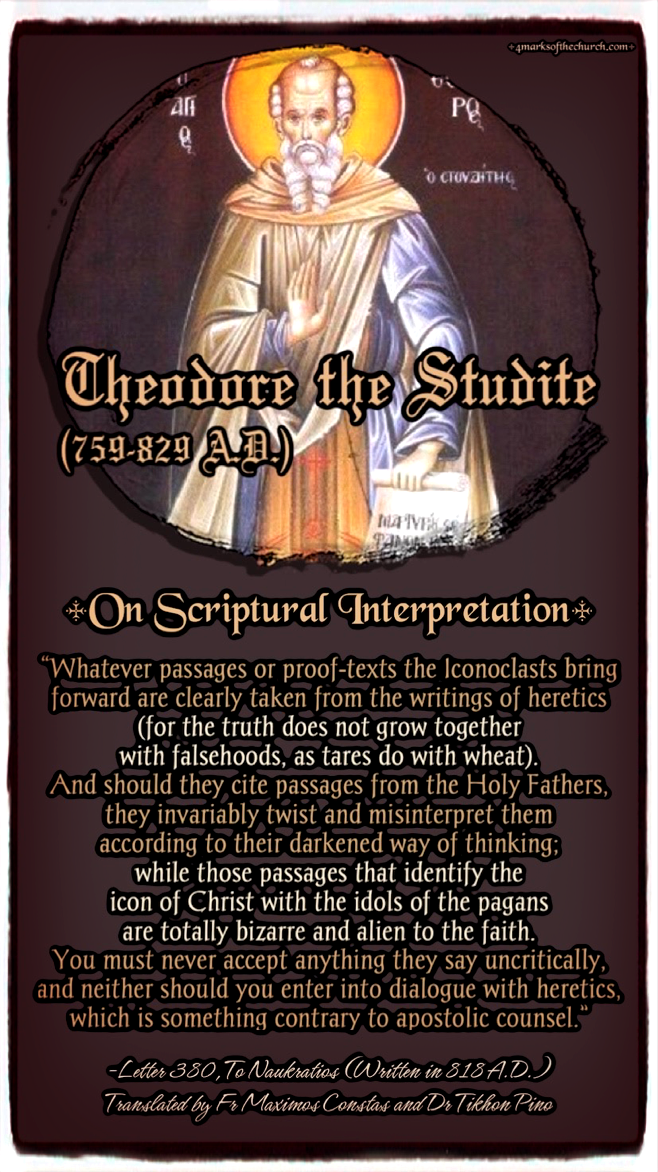
Theodore the Studite (759–826), also known as Theodorus Studita, was a Byzantine Greek monk and abbot of the Stoudios Monastery in Constantinople.
In 794, the Byzantine Emperor Constantine VI (r. 776–797) decided to separate from his first wife, Maria of Amnia, and to marry Maria’s kubikularia (Lady-in-waiting), Theodote, a cousin of Theodore the Studite. The marriage of Constantine and Theodote was celebrated in 795, although not by the Patriarch who initially resisted the marriage on the grounds that a divorce without proof of adultery was illegal. Instead of the marriage being celebrated by the Patriarch, as was normal, it was instead presided over by a certain Joseph, a priest of Hagia Sophia. This led to the so-called “Moechian controversy,” (from the Greek moichos, “adulterer”), in which Theodore initiated a protest against the marriage from the Sakkudion Monastery, and appears to have demanded the excommunication, not only of the priest Joseph, but also of all who had received communion from him, which, as Joseph was a priest of the imperial church, included implicitly the emperor and his court. As a result, imperial troops were sent to the Sakkudion Monastery, and the community was dispersed. Theodore was flogged, and, together with ten other monks, banished to Thessaloniki. The monks arrived in Thessaloniki in March 797, but did not remain for long; in August of the same year Constantine VI was blinded and overthrown, and his mother Irene, the new empress, lifted the exile. Following the accession of Irene, the priest Joseph was stripped of his office, and Theodore was received in the imperial palace. The monks then returned to the Sakkudion Monastery, but were forced back to the capital in either 797 or 798 on account of an Arab raid on Bithynia. At this time, Irene offered Theodore the leadership of the ancient Stoudios Monastery in Constantinople, which he accepted.
In 813, Emperor Leo V began his reign and, within a year, began to reinstitute Iconoclastic policies. Iconoclasm is the deliberate destruction within a culture of the culture’s own religious images and other symbols or monuments, (usually for religious or political motives) and the people who engage in iconoclasm were referred to as iconoclasts, Greek for “breakers of icons” (εἰκονοκλάσται). The First Iconoclasm occurred between about 726 and 787 and was started by a ban on religious images promulgated by the Byzantine Emperor Leo III the Isaurian and was continued by his son Emperor Constantine V. The First Iconoclasm ended with the Second Council of Nicaea, which first met in Constantinople in 786 but was disrupted by military units faithful to the iconoclast legacy. The council convened again at Nicaea in 787 and decreed that ‘venerable and holy images are to be dedicated in the holy churches of God, namely the image of our Lord and God and Saviour Jesus Christ, of our immaculate Lady the Holy Theotokos, and of the angels and all the saints. They are to be accorded the veneration of honor, not indeed the true worship paid to the divine nature alone, but in the same way, as this is accorded to the life-giving cross, the holy gospels, and other sacred offerings’ (trans. Price, The Acts of the Second Council of Nicaea [Liverpool 2018], 564-5, abbreviated). The iconoclastic policies instituted by Emperor Leo V became known as the Second Iconoclasm.
Theodore began to compose his own polemic against the iconoclasts, the Refutatio. Theodore exercised a wide influence during the first year of his exile, primarily through a massive letter-writing campaign. This continued activity led to an imperial order that Theodore be whipped, which his captors however refused to carry out. In 817, Theodore wrote two letters to Pope Paschal I requesting that he summon an anti-iconoclastic Synod. Theodore’s recognition of papal primacy on the basis of his letters to Pope Paschal I (along with his theology concerning the Dormition/Assumption of Mary) was part of what caused him to be formally canonized by the Catholic Church. As a result of his letters, however, the emperor ordered at least once more that Theodore be flogged, and the command was this time carried out, with the result that Theodore became quite ill. Early in 821, however, Leo V fell victim to a grisly murder at the altar of the Church of St. Stephen in the imperial palace; Theodore was released from exile shortly thereafter. Theodore’s years of exile, regular fasting, and exceptional exertions had taken their toll, and in 826 he became quite ill, dying a short time later.
Writings:
- Letters, Ed. by Georgios Fatouros, Theodori Studitae Epistulae (Berlin, 1992) [two volumes].
- Epistle to Pope Leo III (Book I, Epistle 23)
- Epistle of Theodore and four other Abbots to Pope Paschal (Book II, Epistle 12)
- Epistle to Emperor Michael (Book II, Epistle 86)
- Epistle to Pope Paschal (Book II, Epistle 63)
- Dogmatic Epistle to Naukratios on the Holy Icons (Epistle 380)
- Encomium on the Dormition of Our Holy Lady, the Mother of God
- Poems, Ed. with German translation by Paul Speck, Theodoros Studites: Jamben auf verschiedene Gegenstände (=Supplementa Byzantina 1) (Berlin, 1968)
- Catecheses, two collections. The first collection (the “magna”) ed. A. Papadopulos-Kerameus, Theodori Studitae Magna Catachesis (St. Petersburg, 1904); the second (the “parva”) ed. E. Auvray, S.P.N. et Confessoris Theodori Studitis Praepositi Parva Catachesis (Paris, 1891)
- Sermon on the Apostle Bartholomew, ed. with Italian translation by Giorgio di Maria in V. Giustolisi, ed., Tre laudationes bizantine in onore di San Bartolomeo apostolo (Palermo, 2004).
- Testament English translation by Timothy Miller, in J. Thomas and A. C. Hero, eds., Byzantine Monastic Foundation Documents (=Dumbarton Oaks Studies 35) (Washington, 2000).
return to top ⇑
Quotes and Excerpts:
Testament: Concerning Faith 1:
“Therefore, I believe in the Father and the Son and the Holy Spirit—the holy and consubstantial and primal Trinity, [in whose name] I was baptized and regenerated and perfected. I confess God the Father, God the Son and God the Holy Spirit—the three are one with respect to divinity just as conversely the one is three with respect to individual persons. For the Trinity is one God according to substance although it is divided by the distinction of persons. I also confess that one of the Trinity, our Lord Jesus Christ, came into the flesh out of immeasurable charity, that is to say for
the salvation of our race, having assumed the flesh from the holy and blameless Mother of God.”
“In addition, I follow the six holy and ecumenical councils and reject every error of heretical association. I also follow the Second Council of Nicaea which was recently assembled against the accusers of Christ. I accept and revere the sacred and holy images of our Lord Jesus Christ, of the Mother of God, of the apostles, prophets, martyrs, and of all the holy and just. Moreover, I ask for their undefiled intercessions to propitiate the Godhead. With faith and awe I embrace their all holy relics as full of divine grace. “
Writing to Pope Leo III:
“Since to great Peter Christ our Lord gave the office of Chief Shepherd after entrusting him with the keys of the Kingdom of Heaven, to Peter or his successor must of necessity every novelty in the Catholic Church be referred. [Therefore], save us, oh most divine Head of Heads, Chief Shepherd of the Church of Heaven” -(Theodore, Bk. I. Ep. 23)
Writing to Pope Paschal:
“Hear, O Apostolic Head, divinely-appointed Shepherd of Christ’s sheep, keybearer of the Kingdom of Heaven, Rock of the Faith upon whom the Catholic Church is built. For Peter art thou, who adornest and governest the Chair of Peter. Hither, then, from the West, imitator of Christ, arise and repel not for ever (Ps. xliii. 23). To thee spake Christ our Lord: ‘And thou being one day converted, shalt strengthen thy brethren.’ Behold the hour and the place. Help us, thou that art set by God for this. Stretch forth thy hand so far as thou canst. Thou hast strength with God, through being the first of all.” -(Letter of St. Theodore and four other Abbots to Pope Paschal, Bk. ii Ep. 12, Patr. Graec. 99, 1152-3)
Writing to Emperor Michael:
“Order that the declaration from old Rome be received, as was the custom by Tradition of our Fathers from of old and from the beginning. For this, O Emperor, is the highests of the Churches of God, in which first Peter held the Chair, to whom the Lord said: Thou art Peter …and the gates of hell shall not prevail against it.” -(Theodore, Bk. II. Ep. 86)
“I witness now before God and men, they have torn themselves away from the Body of Christ, from the Surpreme See (Rome), in which Christ placed the keys of the Faith, against which the gates of hell (I mean the mouth of heretics) have not prevailed, and never will until the Consummation, according to the promise of Him Who cannot lie. Let the blessed and Apostolic Paschal (Pope St. Paschal I) rejoice therefore, for he has fulfilled the work of Peter” -(Theodore Bk. II. Ep. 63).
“In truth we have seen that a manifest successor of the prince of the Apostles presides over the Roman Church. We truly believe that Christ has not deserted the Church here (Constantinople), for assistance from you has been our one and only aid from of old and from the beginning by the providence of God in the critical times. You are, indeed the untroubled and pure fount of orthodoxy from the beginning, you the calm harbor of the whole Church, far removed from the waves of heresy, you the God-chosen city of refuge.” -(Letter of St. Theodor and Four Abbots to Pope Paschal).
“Let him (Patriarch Nicephorus of Constantinople) assemble a synod of those with whom he has been at variance, if it is impossible that representatives of the other Patriarchs should be present, a thing which might certainly be if the Emperor should wish the Western Patriarch (the Roman Pope) to be present, to whom is given authority over an ecumenical synod; but let him make peace and union by sending his synodical letters to the prelate of the First See.” -(Theodore the Studite, Patr. Graec. 99, 1420)
“And, to speak in the manner of David, does not “every man move forward in an image’ (Ps 39:6)? And are not you yourself. O Iconoclast, an image of God? Were you not born according to the paternal likeness?” Letter 380, To Naukratios (Written in 818 A.D.) Translated by Fr. Maximos Constas and Dr Tikhon Pino
“Today, that ark of holiness, wrought with gold and divinely furnished, has been lifted up from her tabernacle on earth and is borne towards the Jerusalem above, to unending rest; and David, the ancestor of Christ, poet as he is, strikes up a song for us and cries, ‘Virgins’ -meaning souls- ‘will be led to the King’ -to you O God- ‘behind her (Ps 45:14).” -Encomium on the Dormition of’ Our Holy Lady, the Mother of God (Written 747 A.D.)
“For the Trinity is one God according to substance although it is divided by the distinction of persons. I also confess that one of the Trinity, our Lord Jesus Christ, came into the flesh out of immeasurable charity, that is to say for the salvation of our race, having assumed the flesh from the holy and blameless Mother of God.” – Testament: Concerning Faith, Chapter 1 (Written 826 A.D.)
“This is because the icon is the impression of a vision that one has seen with his own eyes, not unlike the like light of the moon -if I may use a familiar example from our own experience- in relation to the light of the sun. Because if this is not what the icon is, then what benefit to the people of old was the Tent of Witness, which was an imitation of heavenly realities? For among other things contained therein was the glorious cherubim, which overshadowed the altar of propitiation, that is, images made with anthropomorphic features. All these things had an anagogical function and were allegories of worship in the spirit (cf. John 4:23).” – Letter 380, To Naukratios (Written in 818 A.D.) Translated by Fr. Maximos Constas and De Tithon Pino
“Do you see how the one adds the painted image to the written text, and how the visual experience of the former is so great that it causes the demons to wail? Do you see how the other calls an icon “venerable,” so that it had the ability to move a courtesan to chastity? Or how the other did not walk away without tears in his eyes after seeing a painted image of a martyr undergoing martyrdom?” – Letter 330 to Naukratios (Written in 818 A.D.) Translated by Fr. Maximas Constas, and Dr Tilhon Pino
“Long ago, death took charge of the world through our ancestor Eve; but now it has engaged in combat with her blessed daughter and been beaten away, conquered by the very source from whom it had received its power. Let the race of women rejoice, then, for it has received glory in place of shame! Let Eve be glad, for she is under a curse no more, having produced in Mary a child of blessing.” – Encomium on the Dormition of Our Holy Lady, the Mother of God (Written 797 A.D.)
“At this moment her natural form, radiant as the sun, is hidden; yet her light shines through her painted image, and she offers it to the people for the life-giving kiss of relative veneration, even if the heretics are unwilling. The holy dove has flown to her home above, yet she does not cease to protect those below; …gathered up to heaven, she banishes demons by her intercession with the Lord.” – Encomium on the Dormition of Our Holy Lady, the Mother of God (Witten 797 A.D.)
“Now the Mother of God shuts her material eyes, and opens her spiritual eyes towards us like great shining stars that will never set, to watch over us and to intercede before the face of God for the world’s protection. Now those lips, moved by God’s grace to articulate sounds, grow silent, but she opens her [spiritual] mouth to intercede eternally for all of her race. Now she lowers those bodily hands that once bore God, only to raise them, in incorruptible form, in prayer to the Lord on behalf of all creation.” -Encomium on the Dormition of Our Holy Lady, the Mother of God (Written 797 A.D.)
“See, now: the mother giving birth is also still an incorrupt virgin, because God was the cause of her conceiving! So in your life- giving sleep, since you are different from all the rest, you alone have rightly found incorruption for both [body and soul].” – Encomium on the Dormition of Our Holy Lady, the Mother of God (Written 797 A.D.)
“Whatever passages or proof-texts the Iconoclasts bring forward are clearly taken from the writings of heretics (for the truth does not grow together with falsehoods, as tares do with wheat). And should they cite passages from the Holy Fathers, they invariably twist and misinterpret them according to their darkened way of thinking; while those passages that identify the icon of Christ with the idols of the pagans are totally bizarre and alien to the faith. You must never accept anything they say uncritically, and neither should you enter into dialogue with heretics, which is something contrary to apostolic counsel.” – Letter 380, To Naukratios (Written in 818 A.D.)
return to top ⇑